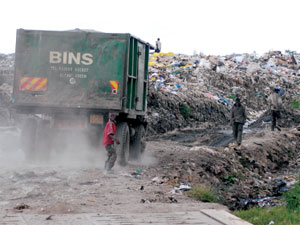By Boniface Ongeri
I arrived unannounced, startling the group of young men from their siesta. For a moment, they were hostile, as a pack of dogs growled menacingly.
"Who are you?" one demanded. I smiled apologetically and announced my mission.
I was returning to the 32-acre Nairobi dumpsite located in Dandora – for the first time since leaving school in 2002.
I attended James Gichuru Primary School in the late 1990s, and had returned to confront my childhood.
 |
- A delivery truck at the dump. Trucks from the airports were especially popular with scavenging pupils. They relished the fresh leftovers, all washed down with bottled water, also retrieved from the same dump. [PHOTOS: BONIFACE OKENDO/STANDARD] |
After hearing me out, the young men relaxed. One of them, Anthony Kimani, put on an overall whose original colour was not discernible, and offered me a tour of the expansive site.
The dump was like the centres of candies for pupils, and I remember being offered a chunk of chocolate when I threw a tantrum on my first day in school.
"The plate", as we fondly called the dump, reflected its nourishing nature, rather than the eyesore that most now think of it.
During break-time, we would dash to the dump for candies, chocolate, sweets, ice cream, biscuits, fruits, juice, name it.
This ritual was repeated in the evening on our way home.
This was the place I had my first taste of what I would later learn was pizza!
Adventurous boys
Growing up in Eastlands, we would descend the site and help ourselves to any edibles during weekends and holidays as well.
Stay informed. Subscribe to our newsletter
This is not to say we lacked food at home; the lure of the dump was just too alluring to adventurous boys with little activity on their hands.
Our school, nestling the dump, was the envy of pupils from schools such as Tom Mboya, Wangu, Ronald Ngala, Dandora Public primary schools, as well as the Dandora Mixed Secondary School.
When we met youngsters from other schools in the evening, displaying our collection of goodies, most were openly envious.
A number arm-twisted their parents be transferred to learn near "the plate."
Bottled water
We had mastered the garbage collection vehicles. The most popular were those that came from the Wilson and Jomo Kenyatta International Airports. The leftovers from those locations tended to be of fairly good quality, washed down with juices and bottled water. The vehicles that were loathed most were those belonging to the local authorities because they delivered murky trashes from city estates.
But those in need of recyclable materials for resale ran after them.
Truancy was common when the vehicles from the airports were expected. Their arrival stirred life in our school and its vicinity.
The drivers were accorded the respect only reserved for teachers. Back then, the school fence was vandalised, making the walk into the dump a walk in the park.
Some of the teachers were beneficiaries of whatever we picked from the dump, presumably with the full knowledge of the source of our loot.
A tarmacked road that separated the school from the dump was covered in the mountains of garbage stretching to the horizon.
Efforts by teachers to prevent pupils from visiting the area were fruitless as the garbage spilled into the school compound, taking up a portion of the playing field.
Some of us were enterprising enough to make a shilling from the sale of the sweets to other pupils from other schools who never ventured in the site.
Looking back, I am amazed we lived to tell the story, and escaped the skin infections and respiratory illnesses that plagued some colleagues.
Revolting smell
The school is now barricaded with a high stonewall to prevent garbage spilling over. My guide Kimani said scavenging in the dump has reduced significantly.
After spending some hours walking around, I discovered the stench had grown unbearable. I don’t recall the dump having a revolting smell in our younger days. Then, it was just a stretch of field with no humanity in sight. The dump was commissioned in the 1970s when there were no settlements around it.
Highrise buildings and shanties have since cropped up next to the site. It is the dwellers who want the dump moved.
But those who earn a living from the dump say their livelihoods are threatened.
In one corner of the dump, a group of glue-sniffing teenagers chased after a plastic can.
Among the spectators of the game was a group of drifters and homeless boys lying on rolled up mattresses. It was evident they were home.
Few were ready to consider the possibility of the dump relocating.
I asked Kimani what he thought the future holds for the dump. "It is here to stay," he said with finality. "Just like the River Nile is the lifeblood of Egypt, so is the dumpsite to Dandora. Dandora cannot do without the dumpsite."
Before leaving, I decided to visit my former school. I reminisced about the bar of chocolate handed to me by a senior pupil during my first day in the school to calm me down.
A marabou stork flew inches above my head amid the acrid smell of rotting garbage.
I went up a five-storey building. Rugged mountains of trash extended to the horizon, as pigs and dogs sniffed the rubbish side by side, as did marabou storks, their long and feathered wings astride, like bored soldiers.
 The Standard Group Plc is a
multi-media organization with investments in media platforms spanning newspaper
print operations, television, radio broadcasting, digital and online services. The
Standard Group is recognized as a leading multi-media house in Kenya with a key
influence in matters of national and international interest.
The Standard Group Plc is a
multi-media organization with investments in media platforms spanning newspaper
print operations, television, radio broadcasting, digital and online services. The
Standard Group is recognized as a leading multi-media house in Kenya with a key
influence in matters of national and international interest.
 The Standard Group Plc is a
multi-media organization with investments in media platforms spanning newspaper
print operations, television, radio broadcasting, digital and online services. The
Standard Group is recognized as a leading multi-media house in Kenya with a key
influence in matters of national and international interest.
The Standard Group Plc is a
multi-media organization with investments in media platforms spanning newspaper
print operations, television, radio broadcasting, digital and online services. The
Standard Group is recognized as a leading multi-media house in Kenya with a key
influence in matters of national and international interest.







